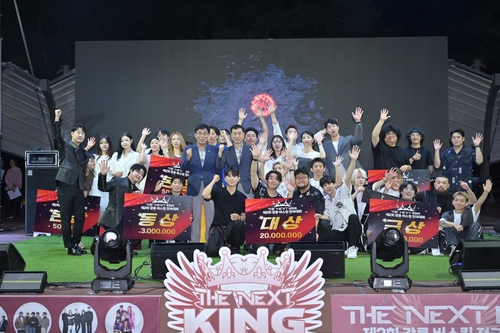Why is this stage so hot in Gangneung?
The night smelled of summer.
On Aug 16, 2025, a crowd filled the temporary stage area at Gyeongpo Lake Plaza in Gangneung, a coastal city in Gangwon Province known for beaches and festivals. (Busking means street performance—music, dance, spoken word—in public places.)
At the final that evening, I felt both the competitive tension of a contest and the celebratory atmosphere of a local festival at once.
The Gangneung Busking National Contest registered itself as another major regional cultural event.
The venue hosted eight finalist acts, invited singers, bakery and drink stalls, and a free beer tasting zone.
A total of 613 teams—1,802 people—applied, and eight acts advanced through preliminary rounds to perform in the final.
The grand-prize winner, a local act called "Oromsae," took home 100 million won, though reports said the actual take-home pay was much lower after taxes (about 20 million won, roughly $15,000).
These figures are more than statistics; they hint at shifts in the local arts ecosystem.
A small ripple made a big wave
A single stage can change how a town looks and feels.
Busking started as an improvised, small-scale form of communication between performer and passerby.
However, once it grows into a national-level contest, the square and the stage expand and audience numbers climb exponentially.
That expansion can be seen as cultural growth. On the other hand, it can be read as a change in the art form's essential nature.
Gangneung city saw a need to strengthen cultural content for tourism, and policy incentives nudged that change.
Meanwhile, local government support and merchants' expectations combined so busking is positioning itself as an economic pillar for the area.
Consequently, performers gained larger stages and new revenue opportunities, yet they also faced increased competition and became subject to rules and regulations.
"The audience completes the stage," and that feels right
The audience makes the show whole.
At the final, children and seniors sat side by side.
The crowd's response gave performers fresh energy, and for those moments street music became part of an official festival.
Some hailed that scene as a commercial success; others worried the free-spirited nature of busking was being lost.
An organizing-committee member said, "Our goal is to revitalize local culture and attract visitors."
Meanwhile, a representative of the participants said that prize money and stage experience motivated artists, but they asked for improvements on taxation and judging fairness.
Cultural critic Kim Suhyun (a pseudonym) argued, "We must protect busking's immediacy while designing fairer contest operations."
Winds of change in Gangneung
This contest is a new experiment for the city.
Analysts say the event works as a tool to expand Gangneung's brand beyond beaches and seasonal festivals.
Indeed, bringing visitors and stimulating local shops are clear benefits.
However, those gains come with real costs: noise, litter, and inconvenience for residents.
Residents generally appreciate the festival vibe, but they demand sustainable management and crowd control.
On the other hand, concerns about judging transparency persist. Audience voting, expert panels, and social-media buzz all interact, which can open the door to fairness controversies.
Some suggest that making judge rosters and scoring criteria public could ease these worries.
A city choosing a new challenge
The debate over pros and cons will not end quickly.
Supporters point to cultural activation, economic benefits, and talent discovery.
Opponents raise alarms about commercialization, loss of the form's essence, and environmental impacts.
Both sides have valid points.
Looking closely at the pro side:
Festival-driven tourism can boost real revenue for local shops. The fact that 613 teams and 1,802 applicants signed up shows national interest, and the contest can serve as a platform to discover new artists. The case of Oromsae winning the top prize turned local performers into visible names, and over time such exposure could increase cultural diversity in the city. With competent planning from organizers and municipal support, Gangneung's brand value as a cultural destination could rise.
On the other hand, critics argue:
As the contest grows, so does competitive pressure, and improvisational, spontaneous performances risk being standardized. Large prizes change participants' motivations, which could narrow artistic styles. Taxation issues—like the reported reduction of the 100 million won prize to about 20 million won after taxes—reveal structural problems in how rewards are handled. For residents, the festival's flip side includes noise, garbage, and crowding; these external costs can build resentment if not properly managed. Finally, doubts about judging fairness remain a core variable that affects trust in the contest.
Therefore, the dispute goes beyond a simple pro-or-con argument. It ties into institutional design and cultural policy.
Proposed remedies include transparent judging criteria, mandatory public consultations with residents, tax and prize-structure reforms, and operational manuals for cleanliness and noise control.
At the same time, to preserve busking's essential value, organizers might consider a separate category for amateur and spontaneous performances.

The second Gangneung Busking National Contest in 2025 drew applications from 613 teams, a sign of strong national interest.
Positive effects include cultural activation and tourism, while concerns focus on commercialization, environmental impact, and judging fairness.
Experts recommend institutional fixes—transparent judging, resident consultations, and tax reforms—alongside practical measures for crowd and noise management.
Question for readers: As the contest grows, how should the city rebalance the needs of the community and the integrity of the art?